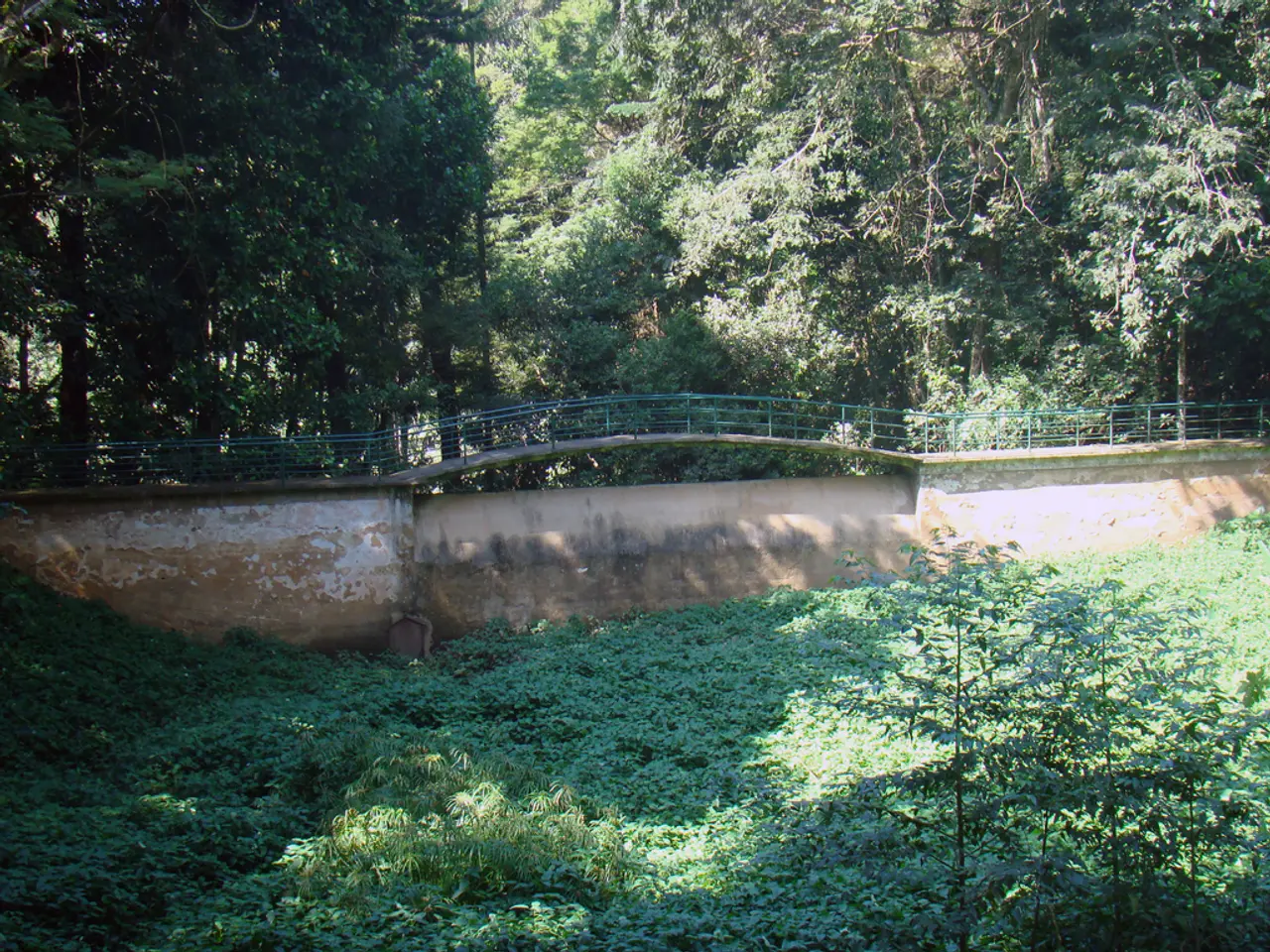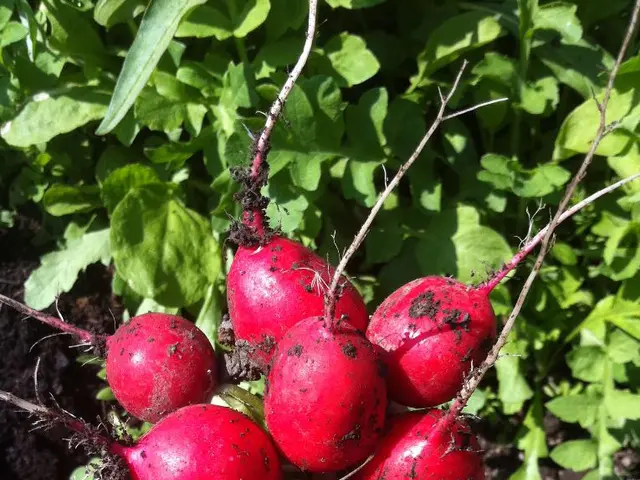Vertical Vegetable Gardening on a Fence: Discover the Top 8 Vegetables to Cultivate and Maximize Your Space Efficiency
In the quest for a more sustainable and self-sufficient lifestyle, vertical gardening has emerged as an innovative and space-efficient solution. This gardening method allows homeowners to grow a variety of plants, from fruits and vegetables to herbs, in limited spaces.
Bonnie L. Grant, a professional landscaper with a Certification in Urban Gardening, has been gardening and writing for 15 years. She shares her expertise on the benefits and techniques of vertical gardening.
Different structures suitable for vertical gardening include a variety of creative and space-efficient options, each catering to different plant types and space constraints.
| **Structure Type** | **Description** | **Example Plants** | |------------------------|-------------------------------------------------------------------------------------------------------------|------------------------------------------------------| | **Green Wall (Living Wall)** | A self-sufficient vertical garden with plants rooted in framework, nourished by built-in drip irrigation, often mounted on walls. | Ferns, mosses, succulents, herbs, small flowering plants | | **Pallet Planter** | Old wooden pallets used sideways with slats as shelves or with attached pots for rustic vertical planting. | Herbs, succulents, small flowers | | **Gutter Garden** | Upcycled rain gutters mounted horizontally or hung with drainage holes for growing shallow-rooted plants. | Lettuce, strawberries, herbs | | **Hanging Pots/Baskets**| Clay or other pots suspended using rods or hooks, ideal for balconies or small areas. | Trailing herbs like thyme, flowering plants, ferns | | **Trellises and Arbors**| Vertical supports that help climbing plants grow upwards; can be standalone or attached to fences or walls. | Tomatoes, cucumbers, peas, beans | | **Shelves** | Multi-level shelves to place containers and pots, ideal for smaller leafy greens and herbs. | Spinach, lettuce, herbs | | **Ladder Gardens** | Old ladders repurposed to hold multiple pots at different levels, enhancing vertical space usage. | Flowers, small veggies, herbs | | **Wire Mesh or Fencing**| Mesh or fencing attached to walls to support climbing plants for vertical growth. | Beans, cucumbers, peas | | **Vertical Hydroponics**| Soil-less vertical racks or towers using hydroponics for year-round and space-efficient growing. | Leafy greens, herbs, strawberries | | **Bamboo or Wooden Frames**| DIY frames constructed with bamboo or wood to support vines and other climbers. | Vines like tomatoes and cucumbers |
Melons can be grown vertically on a fence or other support structures, but smaller varieties like Honeybun, cantaloupe, Sprite, Minnesota Midget, and Kazakh are suitable for this method. As the fruits grow, tie a hammock or similar support under the melon.
Lettuces and leafy greens, such as red leaf, spinach, sorrel, arugula, Swiss chard, and others, can be grown in a vertical grow wall. For added variety, intersperse some radishes, cherry tomatoes, and other smaller traditional salad fixings in the vertical grow wall for a meal on a wall.
Cucumbers can be grown vertically on a fence or other support structures, with some varieties requiring sturdy support structures due to their large fruits. Growing them on a mesh fence is ideal for exposure to sun on both sides. The Mexican sour gherkins, or cucamelons, are an interesting variety to grow.
Zucchini can also be grown vertically, with both bush and vine zucchini existing. The older, heirloom types tend to be vining, while the Spineless Beauty hybrid is a delicious and hassle-free variety.
Tomatoes benefit from staking and training to keep the fruit from touching the ground and to introduce maximum sunlight and air. Indeterminate tomatoes can grow up to 12 feet long and will keep producing fruit until the first killing frost.
Snow peas are crisp, little treats that produce beautiful flowers and charming pods when grown upwards. Snow pea vines produce twining tendrils that will help haul the plant upward without needing much training. Runner beans produce long vines and require more training than snow peas, as they need to be regularly tied to a support structure.
Herbs such as thyme, mint, oregano, cilantro, basil, and many more can be grown in an upright, hanging container situation near the kitchen door. They can also be grown vertically in individual housings or hanging from burlap sacks affixed to a wall.
The article features products available from third-party vendors in the platform Shop. Each structure type suits different planting needs based on root depth, sunlight, and water requirements, and can be adapted for indoor or outdoor settings. For example, green walls create a dramatic visual impact for indoors or patios, while gutter gardens and pallet planters are excellent for space-saving in backyards or balconies. Using drip irrigation or hydroponics can enhance water efficiency and plant growth in vertical setups, especially in soil-less systems like green walls or vertical hydroponics.
[1] Vertical Gardening: A Space-Saving Solution for Growing Your Own Produce and Herbs. (2021). [online] Available at: https://www.hunker.com/13417086/vertical-gardening-a-space-saving-solution-for-growing-your-own-produce-and-herbs
[3] 13 Vertical Gardening Ideas for Small Spaces. (2021). [online] Available at: https://www.hunker.com/13417110/13-vertical-gardening-ideas-for-small-spaces
[5] How to Grow a Green Wall: A Step-by-Step Guide. (2021). [online] Available at: https://www.hunker.com/13417125/how-to-grow-a-green-wall-a-step-by-step-guide
Vertical gardening, within the realm of home-and-garden pursuits, offers homeowners a chance to cultivate a variety of plants, such as herbs, in their own lifestyles with innovative space-efficient solutions. For instance, thyme, mint, oregano, cilantro, basil, and other herbs can be grown in vertical, hanging containers, making them accessible in close proximity to the kitchen.
Similarly, gardening enthusiasts seeking to develop a lifestyle with a living wall can grow lettuces and leafy greens like red leaf, spinach, sorrel, arugula, Swiss chard, and others, heightening the visual appeal of their home-and-garden.




